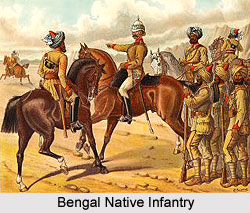 The 3rd Regiment of Bengal Native Infantry was primarily an infantry battalion of the British East India Company, which existed from the year 1798 to 1922. It was a part of the Bengal Native Infantry under the Army of the Bengal province, before the commencement of the Great Revolt of 1857. The Bengal Army was the armed forces of Bengal Presidency and was amongst the 3 main Presidency Armies in British India. The army unit was also incorporated as a part of the Bengal Command. The 3rd Regiment of Bengal Native Infantry was also known as the 3rd Brahman Infantry. King Edward VII acted as the Colonel-in-Chief of the battalion in the year 1904.
The 3rd Regiment of Bengal Native Infantry was primarily an infantry battalion of the British East India Company, which existed from the year 1798 to 1922. It was a part of the Bengal Native Infantry under the Army of the Bengal province, before the commencement of the Great Revolt of 1857. The Bengal Army was the armed forces of Bengal Presidency and was amongst the 3 main Presidency Armies in British India. The army unit was also incorporated as a part of the Bengal Command. The 3rd Regiment of Bengal Native Infantry was also known as the 3rd Brahman Infantry. King Edward VII acted as the Colonel-in-Chief of the battalion in the year 1904.
The 3rd Regiment of Bengal Native Infantry was founded around the year 1798, when the unit was part of the 1st Battalion, 16th Bengal Native Infantry. The regiment was renamed a number of times through out its existence, such as the 32nd Bengal Native Infantry from 1824 to 1861, the 3rd Regiment of Bengal Native Infantry from the year 1861 to 1885, and the 3rd Regiment of Bengal Infantry during 1885 to 1901. In the year 1901, the 3rd Regiment of Bengal Native Infantry was renamed for the last time as the 3rd Brahman Infantry or simply 3rd Brahmans, when the titles of the British Indian presidencies were omitted after the Kitchener reforms of the British Indian Army.
While the regiment was under the British East India Company, it participated in the Second Anglo Afghan War and the First World War. The 3rd Brahman Infantry also participated in the conquest to Bhurtpore (Bharatpur) from 1825 to 1826. The former 3rd Regiment of Bengal Native Infantry was dissolved in the year 1922.
This article is a stub. You may enrich it by adding more information to it. You can send your write-up at content@indianetzone.com



















